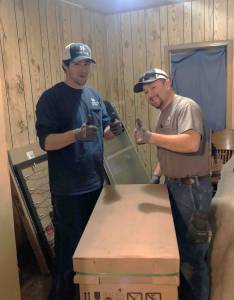Get Answers to Your Heating & Air Conditioning
Questions from the Wichita HVAC Experts

If you don’t find the answer to your question below, just give us a call! We will be happy to help you find a solution to your heating or cooling problem.
Call us anytime at our main Wichita location – (316) 945-3481.
There is no one-size-fits-all heating and cooling solution to homes. Several factors are considered when determining what size of a furnace you need such as square footage, geographic location, insulation and ceiling height. Here in Kansas, we are in zone 3 which is one important factor to consider when finding the right furnace size. Also, the proper BTU will need to be determined. Learn more about understanding BTU and Kansas requirements. The SEER rating is an important factor in determining which cooling unit is the most energy-efficient for your home. Learn about how the SEER rating works and Kansas requirements.
Determining what units are right for your exact home is the first step Hanna Heating & Air takes when we do any new installation. Our trained and experienced HVAC technicians have been installing new systems in homes across Wichita for decades. We would be happy to discuss with you the particulars of your home and what new air conditioning system and/or new heating system is right for you.
The most important thing you can do to protect and prolong your home’s HVAC system is to replace your air filters frequently or if you have permanent filters, to clean the air filters. You may want to consider having your ducts cleaned, which is a service our Hanna technicians provide. Another way to help your HVAC system work as efficiently and completely as possible is to keep your vents open.
This is a common question. The standard recommendation is to change your filter no longer than every 3 months. But that is as long as you’ll want to go, and is only the recommendation for certain homes and inhabitants. For many other homeowners, the recommendation is every 3-4 weeks. Do you live alone? Do you have allergies? Do you have pets? There are many factors that help determine how often you should change your air filter. Take our Air Filter Schedule Calculator to see how often you should be replacing your unit’s filter.
There are a variety of factors to consider in determining whether you furnace is worth repairing or if it should be replaced. How old is your furnace? What is the cost of any repairs you are facing? At Hanna, we don’t pressure anyone into buying a new heating or cooling system. If your old one can be repaired and you decide that’s the better option, we can do that repair work. We will work with you to make sure you understand the benefits and costs of all your options to help you determine what is right for you. Find our Furnace Repair or Replace chart to help you in determining which option is right for you and your home.
The best thing to do is to get a programmable thermostat so that you are utilizing your HVAC system only when needed. This will be both energy efficient and help cut down on your energy costs. A general rule of thumb is to set your temperature for the times people are home over the summer to 78° to 80°. In the winter, the recommended temperature is 70° to 72°. You and your family’s specific needs and comfort levels may determine other temperatures are best for you, but if you find yourself needing to set the temperature well beyond these ranges, there may be an issue or problem with how well your heating and/or cooling system is working for your home. Check for signs that your AC needs repair or indications that something is broken with your heater. If you have any questions or need a licensed technician to inspect your home for problems, contact us at Hanna and we would be happy to help!
There are many reasons why one room isn’t cooling or heating as much as the rest of your house. Some of the causes could be simple fixes that homeowners can do themselves. Check to see if you have any closed vents or if there is any furniture or other items blocking the vents. The amount of sunlight getting into that room could be causing it to be too hot. Simply adding thick drapes may eliminate that problem. However, there could be other issues causing the problem that may require professionals to address such as a lack of proper insulation or having too small of an air conditioning system. Call us and one of our Hanna Heating & Air techs can perform a service check of your home’s situation.
One solution for controlling the temperature to a small section of a home where extending the distribution ductwork isn’t feasible is by installing a Mini-Split system. It’s a small unit that is installed on a wall that will allow you to control the heating and cooling of that particular room. These are often great options for homes with new additions or for apartments. Contact Hanna Heating & Air to see if a Mini-Split will work well for your home.
Be sure that your outdoor unit isn’t dirty and covered with debris. A dirty or clogged condenser unit can greatly reduce its effectiveness and even cause the AC to stop working. If using a weed trimmer near it, be sure to stay clear of any wiring so as not to damage it. We have created a Broken AC Homeowner’s Checklist of what to check when you find your air conditioner isn’t working. Many of the possible fixes are simple tasks you can do yourself and are worth trying before paying someone to handle the job.
SEER stands for Seasonal Energy Efficiency Ratio. The SEER rating factors the quantity of energy your AC unit will need to operate. It is a ratio of how much cooling a system puts out for each unit of energy it consumes. The correct SEER Rating that is right for your home depends on a variety of factors including location and house size. Learn more about the SEER Rating and Kansas requirements on our post explaining what the SEER Rating is.
Explore our HVAC maintenance plans for optimal performance.


